Today we will look at a trio of masks from a variant of the Santiagueros dance, which in some areas of Puebla has the local name of La Danza de Negros. It would seem in this case that the Negros dancers do NOT represent Afro-mestizos or Black people, but rather “dark ones.” In this instance, the Santiagueros have golden beards and the Negros have dark beards, analogous to the white hat/black duality that was once common in American Westerns. Probably the bad guys represent the Spanish conquerors. As I labored to clarify my understanding of these three masks, I was pleased and surprised to recognize that two of them were apparently by the same hand and all three were possibly from the same dance, although I had purchased them as unrelated. They came with limited information, and then a very recent YouTube™ video had revealed identical or similar masks performing in modern and well documented dances (see link that follows the first photo of the female mask). Here is the first mask, which I purchased from Robin and Barbara Cleaver in June of 1988. It was described then as a Santiaguero mask from the Santiagueros dance in Agua de la Mina, in the municipio of Guadalupe Victoria, Puebla. Agua de la Mina is about 25 miles to the northwest of Chichiquila, Puebla, which will serve today as a central reference point.
This Santiaguero is a beautiful old mask with worn paint.
Here is a YouTube™ video of the Danza de Negros in Agua de la Mina, municipio de Saltillo la Fragua, Puebla. It turns out that this is the same Agua de la Mina, but apparently the county seat (municipio) has changed since the time the mask was collected. This (optional) video is poorly focused, so that one cannot see that the dancers are not wearing masks, while another imperfect video (shot sideways) reveals that the dancers wear kerchiefs over their faces in lieu of masks. I offer the blurry one to document their costumes, which are those of Santiagueros in this area of Puebla, and to establish that this dance is still performed in Agua de la Mina, with kerchiefs for masks.
https://www.youtube.com/watch?v=hXXiq3KNsgw
A video from El Carmen in the municipio of Chilcotla, Puebla is in sharp focus and reveals the “Danza de Negritos” in that town, also with kerchiefs instead of masks. El Carmen is about 10 miles south of Agua de la Mina. Masks may have gone out of fashion in Agua de la Mina, although later we will observe that they are still in fashion a little further south in Chichiquila, and that the masks there look just like those in today’s post.
https://www.youtube.com/watch?v=dDrTDS43zq8
The mask has a frowning mouth but it is a Santiaguero rather than a negative figure, such as a Pilato.
Note the hollowing of the beard and the under side of the chin. This mask is 10½ inches tall, 6½ inches wide, and 3½ inches deep.
“A picture is worth a thousand words.” The shaping of the mask and beard is most dramatic from the back, there is extensive staining from use, and there is an original strap.
I obtained the second and third masks from Jaled Muyaes and Estela Ogazón in February of 1997. This one was said to be a Moro from the Moros y Cristianos dance in Puebla. If one closely compares this mask with the last, then it will be obvious that they are very similar on style, as if both were made by the same carver, and soon we will find both styles together in the same dance. I suppose that the difference in hair color does identify the wearer as the opponent of the wearer of the first mask, suggesting that this one is actually a Pilato, or a “dark one” (Negrito or Negro).
I hope you can see how similar this mask is to the one above, in terms of the style of carving. The eyes, for example, are identical, and the beards differ in shape, but not in carving style.
I particularly like the hatching on the sideburns.
The hollowing of the beard and chin is just like what one sees on the first mask.
This mask is 10¼ inches tall, 6½ inches wide, and 4½ inches deep.
The backs of these two masks are virtually identical. There is marked staining from use.
The third of these masks was said to represent Maria Catalina from a dance in Las Trincheras, in the municipio of Chichiquila, Puebla. Historically, Maria Catalina was a patriot during the Mexican Revolution against Spain. Although the dance that one expects to find today in Las Trincheras is that of the Negros, the presence of this single female figure named Maria Catalina reinforces our impression that this is a Santiagueros variation and that the Negros secretly portray the Spanish (who Maria Catalina opposed).
This is an odd-looking and homely face, isn’t it, and with such prominent ears. One would not call this a complimentary portrait. Let this remind us that although Maria Catalina is regarded as a Mexican hero, she was not an Indian, while the dancers are either Indians or Afro-Mestizos. Maria may not be their hero.
All is revealed in this next YouTube video of the Danza de Negros in El Triunfo, municipio of Chichiquila, Puebla, a town just 10 miles north of Las Trincheras Chichiquila, a distance that allows us to assume that they share traditions. El Triunfo and Las Trincheras are in a remote mountainous area near the border between Puebla and Veracruz. In the Triunfo video you will see dancers wearing masks with golden beards that are identical to the first mask, others with black beards that look like the second mask, and a single female dancer dressed as a schoolgirl, and wearing a female mask with prominent ears. The men with the dark-haired masks are dressed in black shirts and black pants, a different costume from that worn by the men with gold beards, and another reference to “Negros” (black clothing).
The dance itself involves dramatic stamping, which reminds me of Negrito dances to the south where dancers with black masks stomp with equal vigor.
https://www.youtube.com/watch?v=l5oJdvbpxE4
Look at the old worn paint on this face. These three masks are likely to date to the 1960s or earlier.
Here is yet another frowning mouth.
This mask is 7 inches tall, 7¼ inches wide, and 3¾ inches deep.
The back is old and worn.
Next week we will look at more masks from the Mexican state of Puebla.
Bryan Stevens

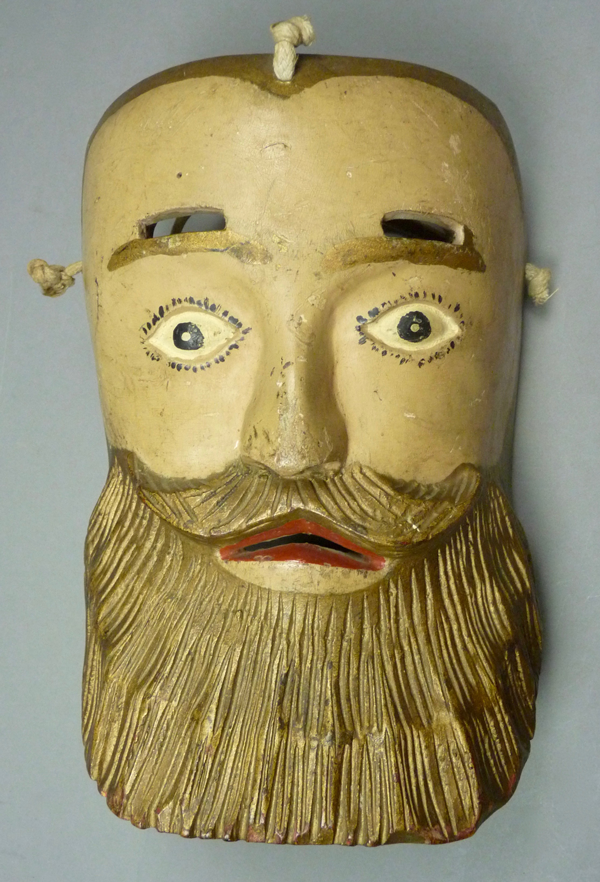
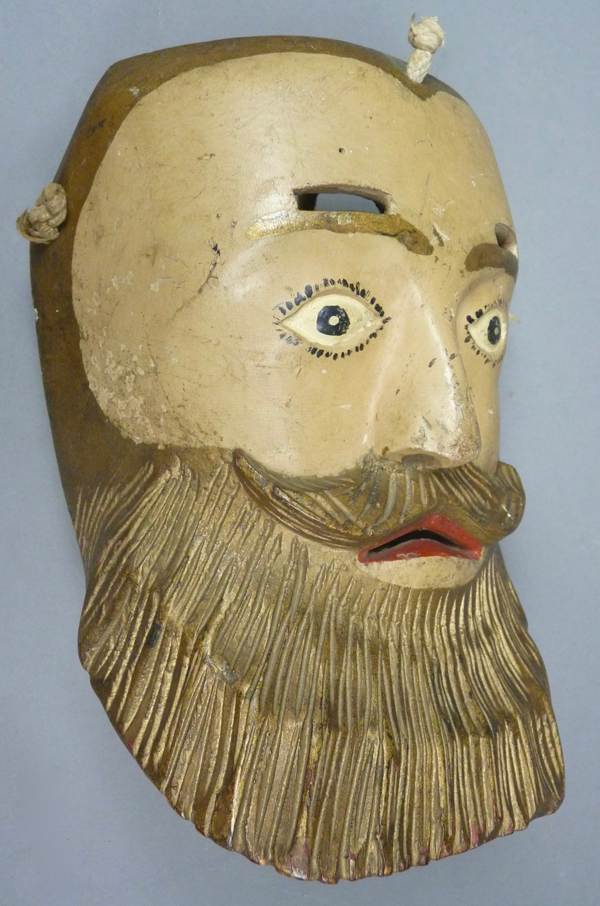
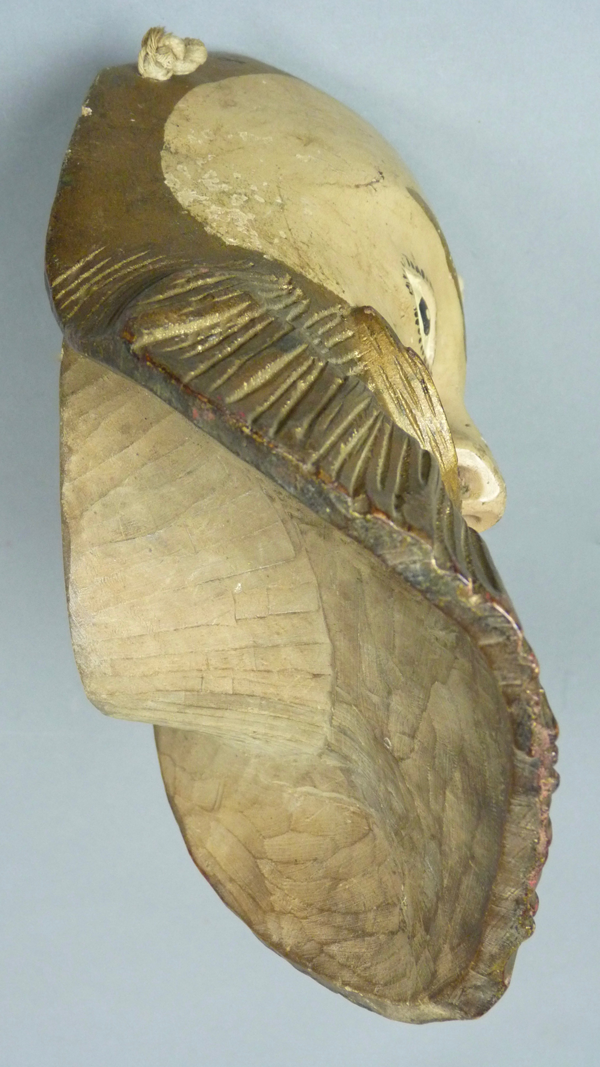
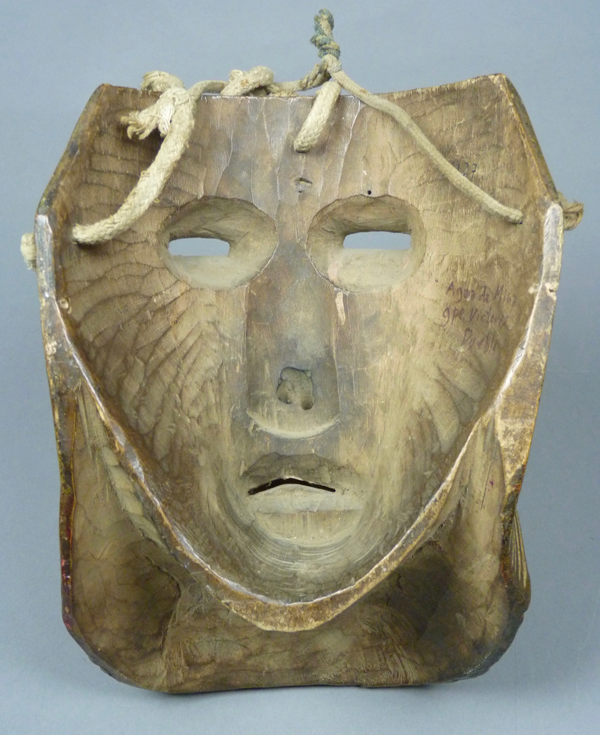
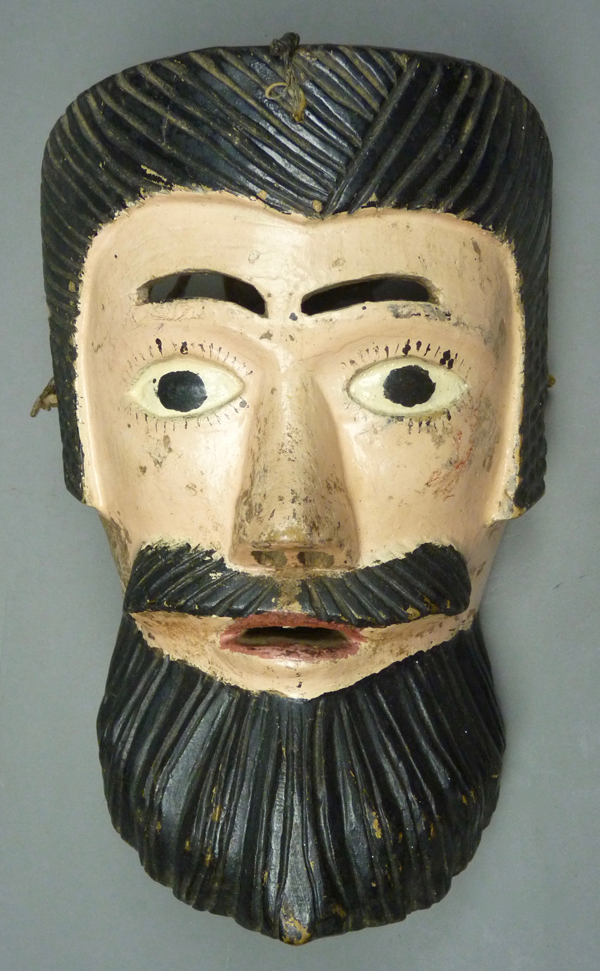
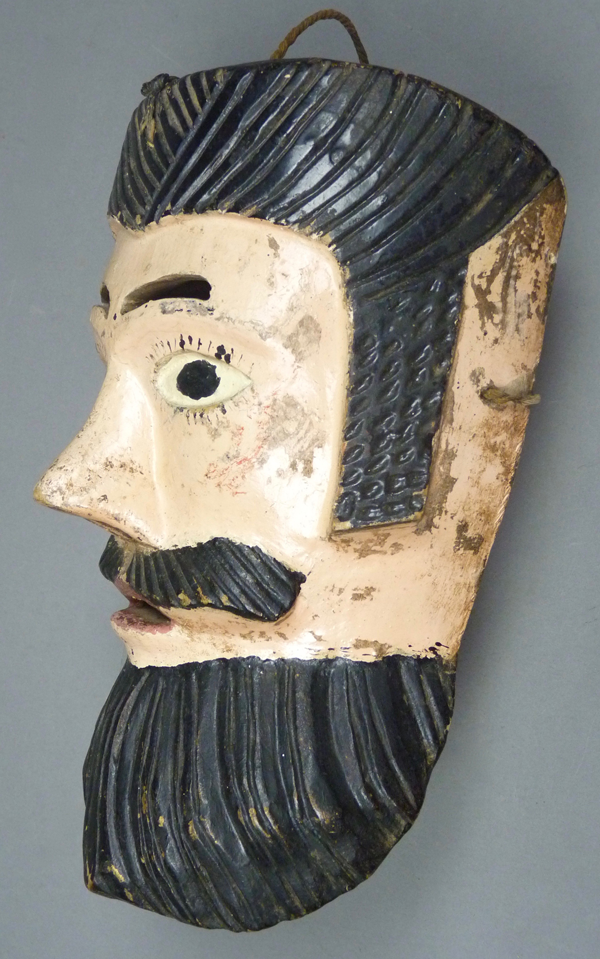
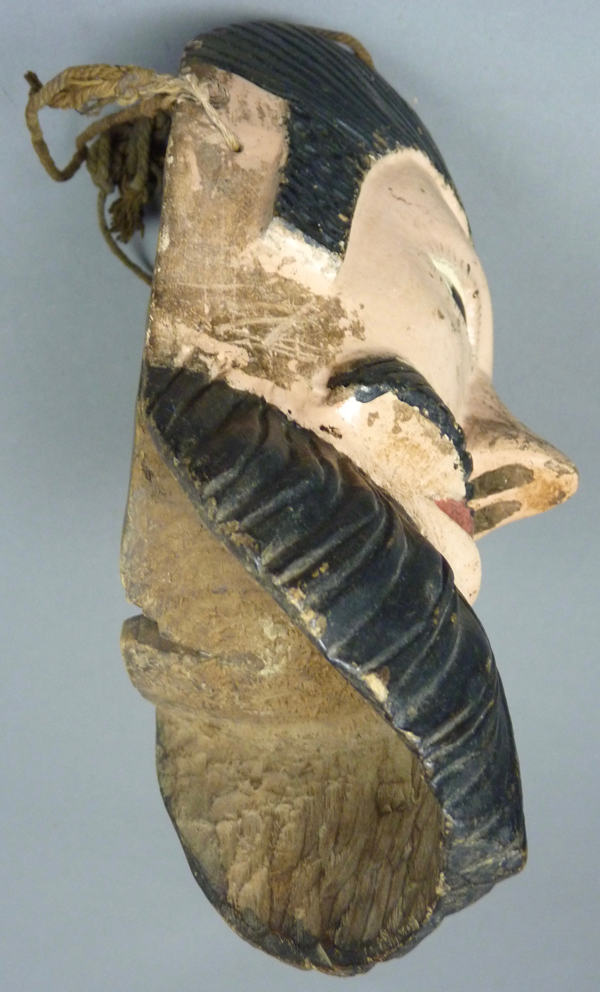
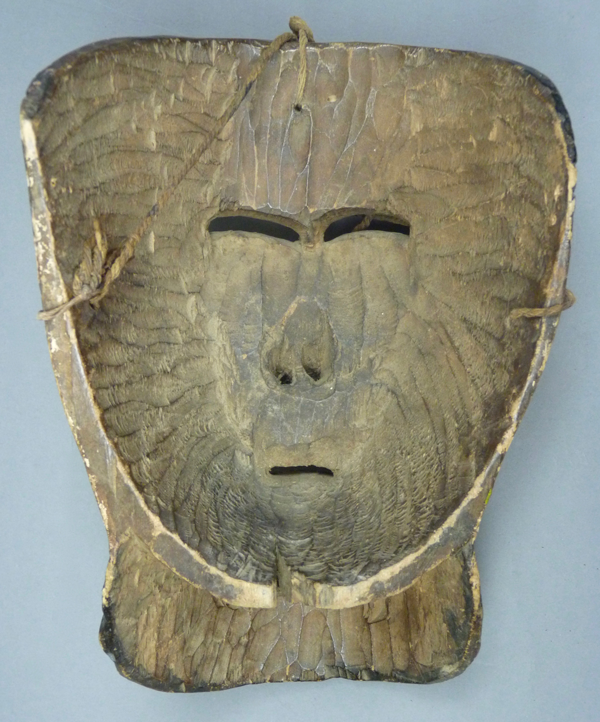
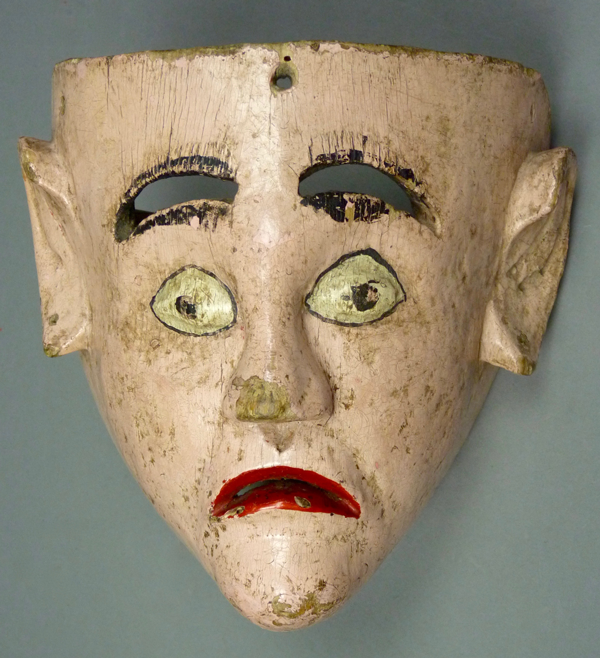
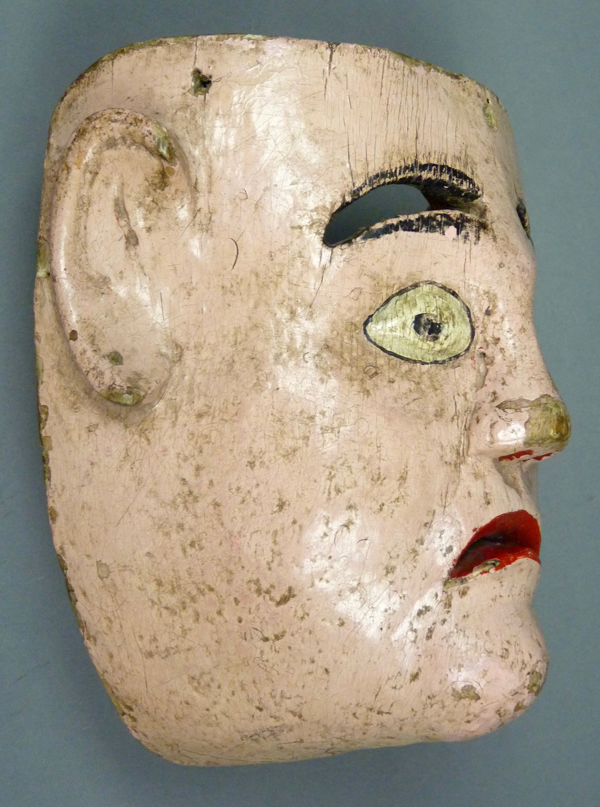

Pingback: Another Etsy Mask Find | Mexican Dance Masks